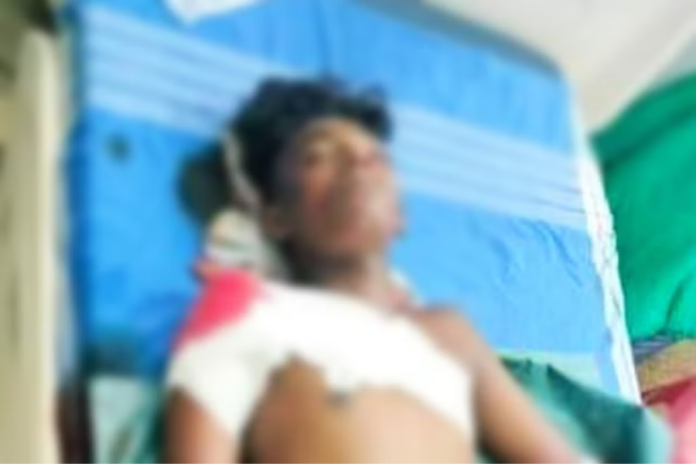Nanguneri Incident: In the Valliyoor-Nanguneri area in Tirunelveli district in southern Tamil Nadu, a 17-year-old teenager and his 14-year-old sister, both members of the Scheduled Community, were allegedly attacked on August 9 by students from the district’s dominant castes.
The siblings are receiving medical care at the Tirunelveli Medical College Hospital.
Tragically, one of the protesters calling for police intervention, a 60-year-old relative of the victims, passed away after fainting during the uproar.
Initial accounts state that the youngster was regularly victimised by peers from the ruling caste, who also invited their anger when he refused to undertake errands for them.
The incident was reported from a government-funded school on the former national highway between Tirunelveli and Nagercoil. There is a sizable playground at the school where you can frequently hear children laughing, playing, and chatting. You might see some students sitting around a tree talking or studying. The setting for the school is ideal.
It is startling and upsetting that such a facility ended up being a caste-based breeding ground.
The horrifying episode serves as yet another illustration of how pervasive the “Jaati-psyche” is in modern society.
Tamil Nadu’s film industry, legislators, and community leaders all have a responsibility to accept some of the blame for the caste violence in the state.
Dravidianism and the parochial sentiment of Tamil uniqueness, which ensure that there is no societal introspection, create a conducive setting for this never-ending cycle of caste violence in the state.
How does Tamil film industry promote caste violence?
Films that glorify violence have been continuously produced by the Tamil cinema industry.
In addition, a lot of films exalt caste.
In the 1990s, the landed castes were exalted in both overt and covert methods. They are now shown as villains. In addition to legal and electoral procedures, violence is often demonstrated as a tool for achieving social justice.
Leaders have been inciting one community against another on the political front.
Inflammatory comments are now circulated and repeated among impressionable adolescents through social media platforms like Youtube, unlike in the past. These videos incite the young, apparently sophisticated minds.
The Viduthalai Chiruthaigal Katchi (VCK) leader Thol. Thirumavalavan and the late Kaduvetti “Guru” both used derogatory speech. They promoted hatred motivated by identification and used identity-based power tactics. They gave talks intended to incite the youth and radicalise them with caste-chauvinism.
There is a new generation of community leaders who engage in the harshest provocations both online and offline without taking even the slightest accountability.
Make no mistake: caste-chauvinism is the last refuge of every criminal who aspires to leadership, and the majority of them have a criminal history.
They bargain with politicians using the vote banks they control in the community. The more votes they have, the more negotiating leverage they have.
The Dravidianist and Tamil-exceptionalist political umbrella is above all of this.
This cover denies the existence of caste conflicts. Instead of dealing with it with honesty, the problem is left unacknowledged.
According to the Dravidianists, all caste disputes are the outcome of a covert plot by the so-called “Brahminical Sanatanists.” In their imagined history, caste distinctions were not a natural part of Tamil culture. In reality, though, they take advantage of every community disagreement to their advantage.
With this strategy, Tamil Nadu has become a state where caste prejudice is not addressed and eliminated but rather covered up and glossed over.
Thus, the horrifying events at Nanguneri have been a result of contributions from virtually every segment of society.
Traditional leaders of Hindu society must step in
However, in the end, neither the film business nor politics can be trusted to bring about true justice and healing.
The Dharmacharyas, who were Hindu Mathadipathis and Atheenams, stepped in during the 1980s when caste tensions in the southern districts threatened to tear apart the social fabric.
They took a thorough tour of each location. They went to each village.
Conflict-affected groups were persuaded to eat at the same restaurants and attend the same temples for worship. Along with the sannyasins, a small van decorated with the Goddess (Mari-Amman) travelled around the villages.
This had a relaxing, therapeutic effect. That calm persisted for a decade—until a fresh batch of films rekindled the extinguished fires.
The Hindu saints and sages, Dharmacharyas and neo-Gurus, are once again on tour, and they will begin in Nanguneri. In this situation, only Sanatana Dharma can offer a healing touch.
The Dharmacharyas, who have the responsibility and power to heal societal traumas, play a significant part. If they don’t act in this crucial situation, they will be seen as failing in their moral obligation.
To ensure that no more blood is shed in the name of caste, the Hindu society must sincerely urge to the Dharmacharyas and Hindu organisations to come together and promote healing.



